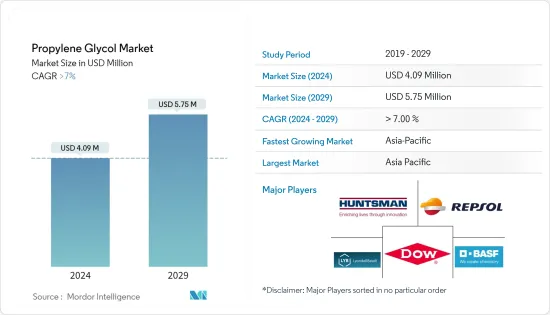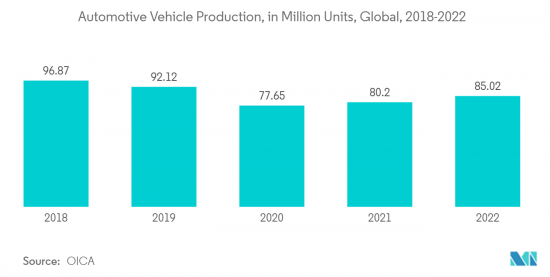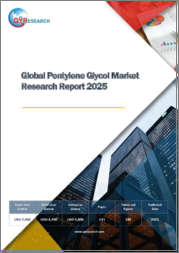
|
시장보고서
상품코드
1406907
프로필렌 글리콜 : 시장 점유율 분석, 산업 동향과 통계, 성장 예측(2024-2029년)Propylene Glycol - Market Share Analysis, Industry Trends & Statistics, Growth Forecasts 2024 - 2029 |
||||||
프로필렌 글리콜 시장 규모는 2024년 409만 달러로 추정되며, 2029년에는 575만 달러에 달할 것으로 예상되며, 예측 기간(2024-2029년) 동안 7% 이상의 CAGR로 성장할 것으로 예상됩니다.

COVID-19 팬데믹은 전국적인 봉쇄, 엄격한 사회적 거리두기, 공급망 혼란으로 인해 시장에 부정적인 영향을 미쳤고, 운송, 건축, 건설 등 최종사용자 산업에 악영향을 미쳐 프로필렌 글리콜 시장에 영향을 미쳤습니다. 그러나 규제가 해제된 후 시장은 순조롭게 회복되었습니다. 프로필렌 글리콜 운송 및 의약품 최종사용자 산업의 소비 증가로 인해 시장이 크게 회복되었습니다.
주요 하이라이트
- 식품 가공 및 첨가제 산업의 수요 증가, 자동차 산업의 수요 증가, 다양한 최종사용자 산업의 용매 수요 증가가 프로필렌 글리콜 시장을 견인할 것으로 예상됩니다.
- 프로필렌 글리콜의 대량 소비로 인한 건강 문제는 시장 성장을 저해할 것으로 예상됩니다.
- 프로필렌 글리콜 생산을 위한 산업 규모의 직접 합성 방법의 개척은 예측 기간 동안 시장에 기회를 가져올 것으로 예상됩니다.
- 아시아태평양은 운송, 건축 및 건설, 제약 최종사용자 산업에서 프로필렌 글리콜 수요가 증가함에 따라 시장을 지배할 것으로 예상됩니다.
프로필렌 글리콜 시장 동향
운송 최종사용자 산업이 시장을 독점
- 프로필렌 글리콜은 운송 분야에서 널리 사용됩니다. 점성, 무색, 무취의 액체입니다. 흡습성이 높고 알코올, 에스테르, 물, 아민 및 케톤에 용해됩니다. 할로겐화 탄화수소와의 혼화성이 낮고 지방족 탄화수소와는 혼화되지 않습니다. 운송 산업에서 광범위하게 사용됩니다.
- 프로필렌 글리콜은 내화성 브레이크액, 유압유, 엔진 냉각 등의 용도로 운송 산업에서 사용되는 냉각제, 페인트 원료의 초기 원료, 항공기 제빙 원료, 고온 용도의 열 매체 등의 제조에 사용됩니다. 프로필렌 글리콜은 불포화 폴리에스테르 수지의 제조에도 사용되며 운송 분야에서 다양한 역할을 수행합니다.
- 세계 자동차 생산량 증가는 프로필렌 글리콜 시장을 견인할 것으로 예상되며, OICA(Organisation Internationale des Constructeurs d'Automobiles)에 따르면, 2021년 세계 자동차 생산량은 8,020대, 2022년에는 8,502만 대에 달해 6%의 성장률을 기록할 것으로 예상했습니다. 중국, 미국, 인도는 세계에서 가장 두드러진 자동차 시장입니다.
- 미국은 중국에 이어 세계 2위의 자동차 시장으로 세계 자동차 시장에서 큰 비중을 차지하고 있으며, OICA에 따르면 미국의 자동차 생산량은 2021년 915만대, 2022년 1,006만대, 성장률은 9%에 달할 것으로 예상했습니다. 이는 자동차 산업의 성장을 강화하고 프로필렌 글리콜 시장 수요를 자극했습니다.
- Boeing Commercial Outlook 2023-2042에 따르면 2042년까지 신형 민간 제트기 수요는 42,595대, 8조 달러에 달할 것으로 예상됩니다. 전 세계 제트기 보유량은 2042년까지 거의 두 배인 48,600대로 매년 3.5%씩 증가합니다. 항공사들은 전 세계 항공기의 약 절반을 연료 효율이 높은 신형 항공기로 교체할 것으로 보입니다.
- 또한 북미는 세계 항공기 생산의 중심지입니다. 미국은 이 지역에서 가장 큰 항공기 시장입니다. 에어버스와 보잉은 미국에서 가장 큰 항공기 제조업체입니다. 예를 들어, 에어버스는 2022년에 661대의 민간 항공기를 인도했고, 연말까지 1,078대의 신규 주문을 받았습니다. 마찬가지로 보잉은 737 Max 8 제트기 57대를 수주해 2025년까지 인도할 예정입니다.
- 따라서 위의 요인으로 인해 운송 최종사용자 산업은 예측 기간 동안 프로필렌 글리콜 시장을 주도할 것으로 예상됩니다.

아시아태평양이 시장을 장악
- 아시아태평양은 자동차, 건설, 식품, 음료 및 식품 최종사용자 산업의 수요가 증가함에 따라 프로필렌 글리콜 시장을 지배할 것으로 예상됩니다. 이 지역에서는 중국, 인도, 일본이 가장 큰 프로필렌 글리콜 시장입니다.
- 프로필렌 글리콜은 불포화 고분자 수지를 제조하는 데 사용되며, 덕트 파이프 및 바닥 시트와 같은 건설 제품을 제조하는 데 사용됩니다. 페인트 산업에서 프로필렌 글리콜은 페인트의 용매로 사용됩니다.
- 중국은 세계 최대 건설 시장으로 전 세계 건설 투자의 20%를 차지합니다. 중국은 2030년까지 건축과 건설에 13조 달러에 가까운 투자를 할 것으로 예상됩니다. 따라서 중국의 프로필렌 글리콜에 대한 전망이 밝을 것으로 예상됩니다.
- 인도 정부는 약 13억 명에게 주택을 공급하기 위해 주택 건설을 적극적으로 추진하고 있습니다. 인도는 향후 7년간 약 1조 3,000억 달러의 주택 투자를 통해 6,000만 채의 주택을 새로 건설할 예정입니다. 2024년까지 저렴한 주택이 약 70% 증가할 것으로 예상됩니다.
- 또한, 프로필렌 글리콜은 커피 음료, 액체 감미료, 아이스크림, 휘핑 유제품, 탄산음료 등 다양한 식용 품목에도 사용됩니다. 식음료 수요 증가는 이 지역의 프로필렌 글리콜 시장을 창출할 것으로 예상됩니다.
- 중국은 이 지역에서 가장 큰 식음료 시장입니다. 중국 국가경공업위원회에 따르면, 연매출 2억 8,000만 달러 이상의 주요 식품 제조 기업은 2022년 1조 5300억 달러 이상의 매출을 기록했으며, 2021년과 비교했을 때 총 매출은 전년 대비 5.6% 증가해 식품 산업의 강력한 성장세를 보였습니다.
- 위의 요인으로 인해 아시아태평양의 프로필렌 글리콜 시장은 예측 기간 동안 크게 성장할 것으로 예상됩니다.
프로필렌글리콜 산업 개요
프로필렌 글리콜 시장은 본질적으로 부분적으로 통합되어 있습니다. 시장의 주요 기업으로는 LyondellBasell Industries Holdings BV, BASF SE, Repsol, Dow, Huntsman International LLC 등이 있다(순서무관).
기타 혜택:
- 엑셀 형식의 시장 예측(ME) 시트
- 3개월간의 애널리스트 지원
목차
제1장 서론
- 조사 가정
- 조사 범위
제2장 조사 방법
제3장 주요 요약
제4장 시장 역학
- 성장 촉진요인
- 식품 가공 및 첨가물 산업의 프로필렌 글리콜 수요
- 자동차 산업으로부터의 수요 증가
- 다양한 최종 이용 산업으로부터의 용제 수요 증가
- 성장 억제요인
- 프로필렌 글리콜 대량 소비에 의해 발생하는 건강 문제
- 기타 저해요인
- 산업 밸류체인 분석
- Porter's Five Forces 분석
- 공급 기업의 교섭력
- 구매자의 교섭력
- 신규 참여업체의 위협
- 대체품의 위협
- 경쟁 정도
제5장 시장 세분화(금액 기준 시장 규모)
- 그레이드별
- 산업
- 식품·음료
- 의약품
- 용도별
- 향료
- 부동액·소포제
- 불포화 폴리에스테르 수지
- 화학 중간체
- 기타 용도(산화방지제, 가정용품 등)
- 최종 이용 산업별
- 운송
- 건축·건설
- 식품·음료
- 퍼스널케어
- 의약품
- 기타 최종 이용 산업(일렉트로닉스, 페인트와 코팅 등)
- 지역별
- 아시아태평양
- 중국
- 인도
- 일본
- 한국
- 기타 아시아태평양
- 북미
- 미국
- 캐나다
- 멕시코
- 유럽
- 독일
- 영국
- 이탈리아
- 프랑스
- 기타 유럽
- 남미
- 브라질
- 아르헨티나
- 기타 남미
- 중동 및 아프리카
- 사우디아라비아
- 남아프리카공화국
- 기타 중동 및 아프리카
- 아시아태평양
제6장 경쟁 상황
- M&A, 합작투자, 제휴, 협정
- 시장 점유율(%)**/순위 분석
- 주요 기업의 전략
- 기업 개요
- ADEKA CORPORATION
- ADM
- AGC Chemicals
- BASF SE
- Chaoyang Chemicals, Inc.
- Dow
- Golden Dyechem
- Huntsman International LLC
- INEOS
- Lonza
- LyondellBasell Industries Holdings B.V.
- Repsol
- Shell plc
- SKC Chemicals
- Sumitomo Chemical Co., Ltd.
제7장 시장 기회와 향후 동향
- 산업 규모 프로필렌 글리콜 직접 합성법의 개발
- 기타 기회

The Propylene Glycol Market size is estimated at USD 4.09 million in 2024, and is expected to reach USD 5.75 million by 2029, growing at a CAGR of greater than 7% during the forecast period (2024-2029).
The COVID-19 pandemic had negatively impacted the market due to nationwide lockdowns, strict social distancing measures, and disruption in supply chains, which negatively affected the transportation, building, and construction end-user industries, thereby affecting the market for propylene glycol. However, the market recovered well after the restrictions were lifted. The market recovered significantly, owing to the rise in consumption of propylene glycol transportation and pharmaceuticals end-user industries.
Key Highlights
- The increasing demand from the food-processing and additives industry, the growing demand from the automotive industry, and the rising demand for solvents from various end-user industries are expected to drive the market for propylene glycol.
- The health issues created by the high consumption of propylene glycol are expected to hinder the market's growth.
- The development of industrial-scale direct synthesis methods for propylene glycol production is expected to create opportunities for the market during the forecast period.
- The Asia-Pacific region is expected to dominate the market due to rising demand for propylene glycol in transportation, building and construction, and pharmaceutical end-user industries.
Propylene Glycol Market Trends
Transportation End-User Industry to Dominate the Market
- Propylene glycol is widely used in the transportation sector. It is a viscous, colorless, odorless liquid. It is highly hygroscopic and soluble in alcohols, esters, water, amines, and ketones. It has limited miscibility with halogenated hydrocarbons and is not miscible with aliphatic hydrocarbons. It has a wide variety of applications in the transportation industry.
- Propylene glycol is used to produce fire-resistant brake and hydraulic fluids, coolants used in the transportation industry for applications like engine cooling, and more, as an initial for raw materials of paints, as a raw material for de-icing of planes, and as a heat transfer fluid for high-temperature applications. Propylene glycol is also used to prepare unsaturated polyester resins, with various roles in the transportation sector.
- The increase in the global production of automotive vehicles is expected to drive the market for propylene glycol. According to the Organisation Internationale des Constructeurs d'Automobiles" (OICA), global automotive vehicle production reached 85.02 million in 2022, compared to 80.2 million manufactured in 2021, at a growth rate of 6%. China, the United States, and India are the most prominent automotive vehicle markets globally.
- The United States is the second-largest automotive market in the world after China, which occupies a significant share of the global automotive vehicles market. According to OICA, in 2022, the United States automotive vehicle production reached 10.06 million compared to 9.15 million units manufactured in 2021, at a growth rate of 9%. This enhanced the growth of the automobile industry, which has stimulated the market demand for propylene glycol.
- According to the Boeing Commercial Outlook 2023-2042, the demand for new commercial jets by 2042 is expected to reach 42,595 units, valued at USD 8 trillion. The global fleet will nearly double to 48,600 jets by 2042, expanding by 3.5% annually. Airlines will replace about half of the global fleet with new, more fuel-efficient models.
- Moreover, North America is the hub for aeroplane production in the world. The United States is the largest market for airplanes in the region. Airbus and Boeing are the largest manufacturers of airplanes in the country. For instance, in 2022, Airbus delivered 661 commercial aircraft, registering 1,078 gross new orders by the end of the year. Similarly, Boeing Aeroplane OEM company received orders for 57 of the 737 Max 8 jets, with delivery expected through 2025.
- Hence, owing to the factors mentioned above, the transportation end-user industry is anticipated to drive the market for propylene glycol during the forecast period.

Asia-Pacific Region to Dominate the Market
- Asia-Pacific region is expected to dominate the market for propylene glycol with the increasing demand from automotive, construction, food, and beverage end-user industries. China, India, and Japan are the largest markets for propylene glycol in the region.
- Propylene glycol is used to prepare unsaturated polymer resins, which are used to make construction products like duct pipes and floor sheets, among others. In the paint industry, propylene glycol is used as a solvent in paints.
- China is the largest construction market in the world, encompassing 20% of all construction investments globally. China is expected to spend nearly USD 13 trillion on buildings and construction by 2030. This is anticipated to create a positive outlook for propylene glycol in the country.
- The Indian government has been actively boosting housing construction to provide houses to about 1.3 billion people. The country is likely to witness around USD 1.3 trillion of investment in housing over the next seven years, to witness the construction of 60 million new houses in the country. The availability of affordable housing in the country is expected to increase by around 70% by 2024.
- Furthermore, propylene glycol is also used in various edible items such as coffee-based drinks, liquid sweeteners, ice cream, whipped dairy products, and sodas. The increase in demand for food and beverage products is expected to create a market for propylene glycol in the region.
- China is the largest market for food and beverage in the region. According to the China National Light Industry Council, major food manufacturing companies with an annual turnover of over USD 2.8 million reported revenues of over USD 1.53 trillion in 2022. Compared to 2021, the total revenue registered a year-on-year growth of 5.6%, indicating strong growth in the food industry.
- Owing to the above-mentioned factors, the market for propylene glycol in the Asia-Pacific region is projected to grow significantly during the forecast period.
Propylene Glycol Industry Overview
The propylene glycol market is partially consolidated in nature. Some of the major players in the market include (not in any particular order) LyondellBasell Industries Holdings BV, BASF SE, Repsol, Dow, and Huntsman International LLC, among others.
Additional Benefits:
- The market estimate (ME) sheet in Excel format
- 3 months of analyst support
TABLE OF CONTENTS
1 INTRODUCTION
- 1.1 Study Assumptions
- 1.2 Scope of the Study
2 RESEARCH METHODOLOGY
3 EXECUTIVE SUMMARY
4 MARKET DYNAMICS
- 4.1 Drivers
- 4.1.1 Demand for Propylene Glycol in the Food Processing and Additives Industry
- 4.1.2 The Increasing Demand from the Automotive Industry
- 4.1.3 Rising Demand for For Solvents From Various End-User Industries
- 4.2 Restraints
- 4.2.1 Health Issues Created by The High Consumption of Propylene Glycol
- 4.2.2 Other Restraints
- 4.3 Industry Value Chain Analysis
- 4.4 Porter's Five Forces Analysis
- 4.4.1 Bargaining Power of Suppliers
- 4.4.2 Bargaining Power of Buyers
- 4.4.3 Threat of New Entrants
- 4.4.4 Threat of Substitute Products and Services
- 4.4.5 Degree of Competition
5 MARKET SEGMENTATION (Market Size in Value)
- 5.1 Grade
- 5.1.1 Industrial
- 5.1.2 Food and Beverage
- 5.1.3 Pharmaceutical
- 5.2 Application
- 5.2.1 Flavoring Agent
- 5.2.2 Antifreeze and Deicer Agent
- 5.2.3 Unsaturated Polyester Resins
- 5.2.4 Chemical Intermediates
- 5.2.5 Other Applications (Antioxidants, Household Care, etc.)
- 5.3 End-user Industry
- 5.3.1 Transportation
- 5.3.2 Building and Construction
- 5.3.3 Food and Beverages
- 5.3.4 Personal Care
- 5.3.5 Pharmaceuticals
- 5.3.6 Other End-user Industries (Electronics, Paints and Coatings, etc.)
- 5.4 Geography
- 5.4.1 Asia-Pacific
- 5.4.1.1 China
- 5.4.1.2 India
- 5.4.1.3 Japan
- 5.4.1.4 South Korea
- 5.4.1.5 Rest of Asia-Pacific
- 5.4.2 North America
- 5.4.2.1 United States
- 5.4.2.2 Canada
- 5.4.2.3 Mexico
- 5.4.3 Europe
- 5.4.3.1 Germany
- 5.4.3.2 United Kingdom
- 5.4.3.3 Italy
- 5.4.3.4 France
- 5.4.3.5 Rest of Europe
- 5.4.4 South America
- 5.4.4.1 Brazil
- 5.4.4.2 Argentina
- 5.4.4.3 Rest of South America
- 5.4.5 Middle East and Africa
- 5.4.5.1 Saudi Arabia
- 5.4.5.2 South Africa
- 5.4.5.3 Rest of Middle East and Africa
- 5.4.1 Asia-Pacific
6 COMPETITIVE LANDSCAPE
- 6.1 Mergers and Acquisitions, Joint Ventures, Collaborations, and Agreements
- 6.2 Market Share (%)**/Ranking Analysis
- 6.3 Strategies Adopted by Leading Players
- 6.4 Company Profiles
- 6.4.1 ADEKA CORPORATION
- 6.4.2 ADM
- 6.4.3 AGC Chemicals
- 6.4.4 BASF SE
- 6.4.5 Chaoyang Chemicals, Inc.
- 6.4.6 Dow
- 6.4.7 Golden Dyechem
- 6.4.8 Huntsman International LLC
- 6.4.9 INEOS
- 6.4.10 Lonza
- 6.4.11 LyondellBasell Industries Holdings B.V.
- 6.4.12 Repsol
- 6.4.13 Shell plc
- 6.4.14 SKC Chemicals
- 6.4.15 Sumitomo Chemical Co., Ltd.
7 MARKET OPPORTUNITIES AND FUTURE TRENDS
- 7.1 Development of Industrial-scale Direct Synthesis Method for Propylene Glycol Production
- 7.2 Other Opportunities



















